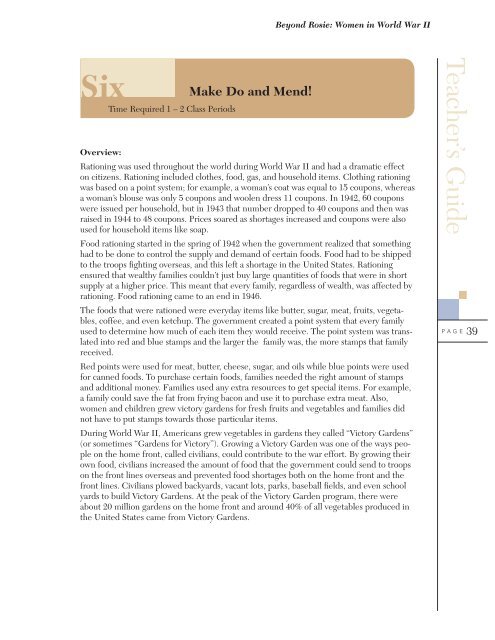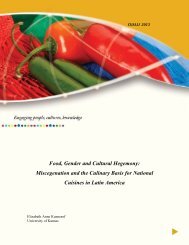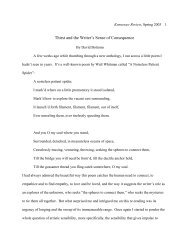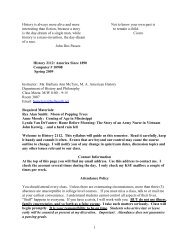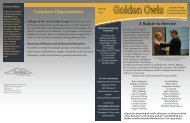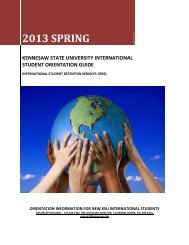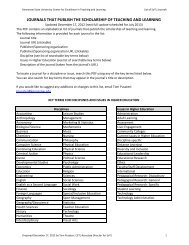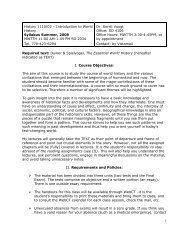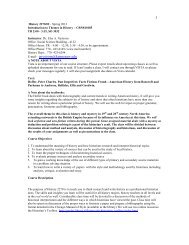Beyond Rosie: Women in World War II - Kennesaw State University
Beyond Rosie: Women in World War II - Kennesaw State University
Beyond Rosie: Women in World War II - Kennesaw State University
Create successful ePaper yourself
Turn your PDF publications into a flip-book with our unique Google optimized e-Paper software.
<strong>Beyond</strong> <strong>Rosie</strong>: <strong>Women</strong> <strong>in</strong> <strong>World</strong> <strong>War</strong> <strong>II</strong><br />
Six<br />
Overview:<br />
Time Required 1 – 2 Class Periods<br />
Make Do and Mend!<br />
Ration<strong>in</strong>g was used throughout the world dur<strong>in</strong>g <strong>World</strong> <strong>War</strong> <strong>II</strong> and had a dramatic effect<br />
on citizens. Ration<strong>in</strong>g <strong>in</strong>cluded clothes, food, gas, and household items. Cloth<strong>in</strong>g ration<strong>in</strong>g<br />
was based on a po<strong>in</strong>t system; for example, a woman’s coat was equal to 15 coupons, whereas<br />
a woman’s blouse was only 5 coupons and woolen dress 11 coupons. In 1942, 60 coupons<br />
were issued per household, but <strong>in</strong> 1943 that number dropped to 40 coupons and then was<br />
raised <strong>in</strong> 1944 to 48 coupons. Prices soared as shortages <strong>in</strong>creased and coupons were also<br />
used for household items like soap.<br />
Food ration<strong>in</strong>g started <strong>in</strong> the spr<strong>in</strong>g of 1942 when the government realized that someth<strong>in</strong>g<br />
had to be done to control the supply and demand of certa<strong>in</strong> foods. Food had to be shipped<br />
to the troops fight<strong>in</strong>g overseas, and this left a shortage <strong>in</strong> the United <strong>State</strong>s. Ration<strong>in</strong>g<br />
ensured that wealthy families couldn’t just buy large quantities of foods that were <strong>in</strong> short<br />
supply at a higher price. This meant that every family, regardless of wealth, was affected by<br />
ration<strong>in</strong>g. Food ration<strong>in</strong>g came to an end <strong>in</strong> 1946.<br />
The foods that were rationed were everyday items like butter, sugar, meat, fruits, vegetables,<br />
coffee, and even ketchup. The government created a po<strong>in</strong>t system that every family<br />
used to determ<strong>in</strong>e how much of each item they would receive. The po<strong>in</strong>t system was translated<br />
<strong>in</strong>to red and blue stamps and the larger the family was, the more stamps that family<br />
received.<br />
Red po<strong>in</strong>ts were used for meat, butter, cheese, sugar, and oils while blue po<strong>in</strong>ts were used<br />
for canned foods. To purchase certa<strong>in</strong> foods, families needed the right amount of stamps<br />
and additional money. Families used any extra resources to get special items. For example,<br />
a family could save the fat from fry<strong>in</strong>g bacon and use it to purchase extra meat. Also,<br />
women and children grew victory gardens for fresh fruits and vegetables and families did<br />
not have to put stamps towards those particular items.<br />
Dur<strong>in</strong>g <strong>World</strong> <strong>War</strong> <strong>II</strong>, Americans grew vegetables <strong>in</strong> gardens they called “Victory Gardens”<br />
(or sometimes “Gardens for Victory”). Grow<strong>in</strong>g a Victory Garden was one of the ways people<br />
on the home front, called civilians, could contribute to the war effort. By grow<strong>in</strong>g their<br />
own food, civilians <strong>in</strong>creased the amount of food that the government could send to troops<br />
on the front l<strong>in</strong>es overseas and prevented food shortages both on the home front and the<br />
front l<strong>in</strong>es. Civilians plowed backyards, vacant lots, parks, baseball fields, and even school<br />
yards to build Victory Gardens. At the peak of the Victory Garden program, there were<br />
about 20 million gardens on the home front and around 40% of all vegetables produced <strong>in</strong><br />
the United <strong>State</strong>s came from Victory Gardens.<br />
Teacher’s Guide<br />
PAGE 39


